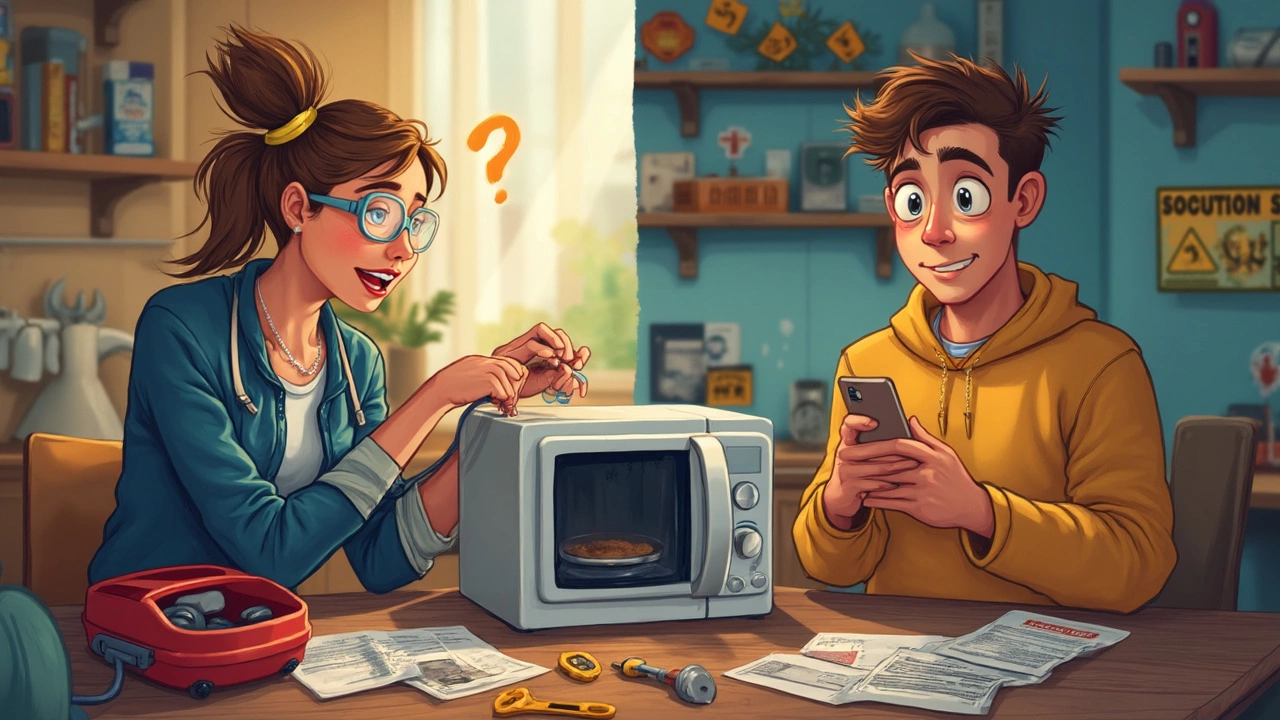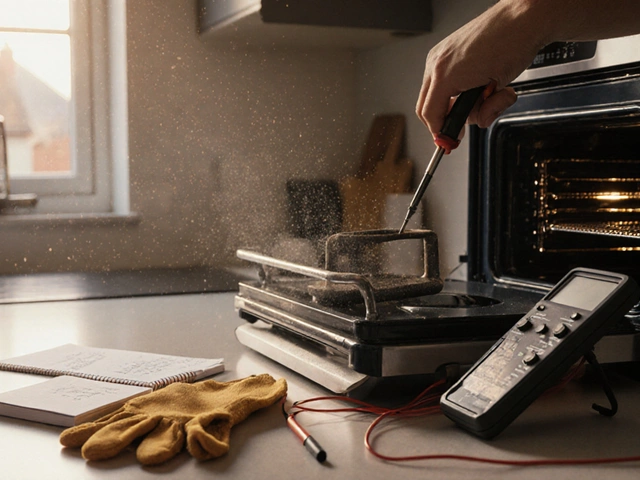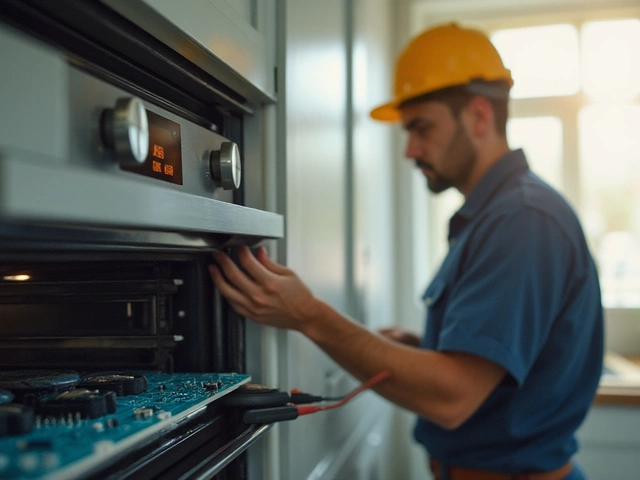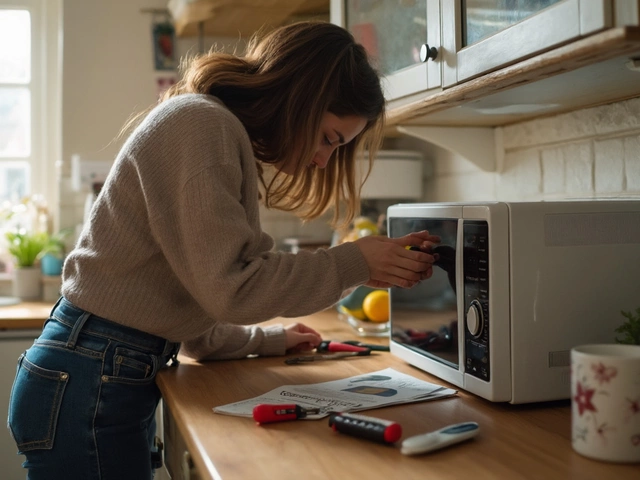Microwave on the fritz? Most folks assume they’re disposable, but honestly, there’s more going on inside than you’d think. Not every problem means you need to spend money on a new one or call a repair service. Sometimes, that stubborn microwave not heating up is just a blown fuse or a messed-up door switch—both are pretty common and don’t always require an engineering degree to fix.
But here’s the deal: microwaves aren’t just mini ovens with extra buttons. There are high-voltage parts tucked inside that can pack a punch even when unplugged. If you’ve ever wondered why repair techs look like they’re approaching a wild animal, that’s why! You need to know exactly what you’re doing or you could get seriously hurt. That’s not just a buzzkill, it’s a hospital trip waiting to happen.
If you’ve got a screwdriver, some patience, and a bit of curiosity, some issues are within reach. Think: replacing a turntable motor, fixing a blown interior light, or swapping a fuse. But if you start poking around the capacitor or magnetron (yep, those are real parts), you’re out of DIY territory and into “better safe than sorry” land. I always remind myself that saving fifty bucks just isn’t worth a nasty shock—or worse. Stick around and I’ll unpack what you can actually fix, what you should skip, and how to spot when the problem is actually just your microwave’s way of saying goodbye.
- What Usually Breaks in a Microwave?
- What You Can (and Probably Can't) Repair Yourself
- Tools, Safety, and Hidden Dangers
- Knowing When to Toss It or Call a Pro
What Usually Breaks in a Microwave?
It’s wild how something as common as a microwave can break in so many ways. Most of the time, it’s the basic parts that croak first—it’s not always some mysterious high-tech meltdown. So what gives out the most? Here are the main troublemakers I’ve run into with microwave repair projects:
- Fuses: These tiny safety devices blow out when there’s a surge or if you slam the door too hard. If your microwave is totally dead, check the fuse first.
- Door switches: These are finicky. If any switch messes up, the microwave won’t even try to start. Sometimes the inside light won’t turn off, either.
- Turntable motors: When your plate stops spinning, food heats unevenly. Usually, a quiet humming or zero movement gives it away.
- Magnetron: This is the powerhouse that actually does the heating. When your microwave runs but food stays cold, it’s probably this guy. Sadly, this isn’t a cheap part.
- Touchpads and control boards: Unresponsive buttons or weird error codes mean the control pieces are fighting you. Sometimes a deep clean works, but often it’s an electrical issue.
- Light bulbs: If the cooking light goes out but everything else works, this is a simple one—even easier than swapping a bulb in your fridge.
Some brands even have a reputation for certain repeat problems: for example, some cheaper microwaves seem to eat door switches for breakfast, while older models with lots of buttons tend to get glitchy keypads. Here’s a quick table with some typical problems and the parts linked to them:
| Common Symptom | Likely Broken Part |
|---|---|
| Microwave won’t turn on | Fuse, door switch, control board |
| Not heating food | Magnetron, high voltage diode, capacitor |
| Turntable not spinning | Turntable motor |
| Light not working | Bulb, bulb socket |
| Buttons not working | Touchpad, control board |
So, if your microwave is giving you the silent treatment, it almost always links back to something simple—at least in theory. The trick is figuring out which part is calling it quits, and whether it’s worth rolling up your sleeves for some DIY microwave work or not.
What You Can (and Probably Can't) Repair Yourself
Let’s get straight to the point: some microwave repair jobs aren’t as scary as they sound. If your microwave stops spinning, lighting up, or randomly won’t start, you’ve got a shot at a DIY fix—with the right know-how and safety steps.
Here’s a quick look at common repairs folks tackle at home:
- Replacing the fuse: If your microwave is totally dead, the fuse might have blown. It usually sits just inside the cover and swapping it out can often bring the unit back to life.
- Door switch issues: If it isn’t starting, the door switch (microwaves have two or three) could be stuck or broken. Swapping in a new one doesn’t need fancy tools, just patience and a steady hand.
- Interior light bulbs: If the light’s out but everything else works, changing the bulb is a quick fix. Some models even let you access the bulb from a side panel—others, you’ll have to pop the cabin open.
- Turntable motor: The spinning tray not moving? Replacing the turntable motor (it’s at the bottom, under the plate) usually takes more time to unscrew the bottom cover than to actually swap the part.
But here’s the flip side—some fix microwave projects should honestly be left alone unless you’re trained. Never mess with the magnetron (it’s the thing actually making the microwaves), capacitor (dangerous even when unplugged), or transformer.
Here’s a basic cheat sheet for common microwave breakdowns, and whether DIY is smart or risky:
| Problem | DIY Safe? | Avg. Fix Time |
|---|---|---|
| Dead/no power | Yes, check fuse | 10-20 min |
| No heat | No, likely magnetron | Call a pro |
| Light won't turn on | Yes, bulb change | 5-15 min |
| Tray doesn't spin | Yes, turntable motor | 15-30 min |
| Weird noises/sparks | No, could be dangerous | Call a pro |
Pro tip: always unplug the unit and, if you’re opening the shell, let it sit untouched for a while—capacitors inside can hold a charge for hours. If you try a repair and the issue still isn’t fixed, or you see burn marks, smoke, or smell anything funky, stop and get help.
Bottom line: you can handle basic fixes, but with anything near the high-voltage parts, go with your gut—and think safety first. The money saved isn’t worth risking your fingers (or more).

Tools, Safety, and Hidden Dangers
Cracking open a microwave isn’t the same as poking around your old toaster. Microwaves run on high voltage even after you unplug them. The big danger zone is the high-voltage capacitor. It can store enough juice to ruin your day, even after sitting for hours. Touching the wrong part can deliver a shock that feels like a kick from a horse—or worse. The safest bet? Only mess with simple stuff, like swapping a light bulb or messing around with the door latch. Anything deeper, and you really need to know what you're doing.
Here’s a basic starter toolkit if you’re serious about microwave repair:
- Standard Phillips and flathead screwdrivers
- Multimeter (for testing fuses and switches)
- Needle-nose pliers (handy for awkward spots)
- Insulated gloves (never hurts for an extra layer)
- Flashlight (seeing inside a microwave is like peering into a cave)
Now, don’t ignore safety advice. According to the U.S. Consumer Product Safety Commission, "Even with the power cord unplugged, the high-voltage capacitor inside a microwave oven can retain a lethal electrical charge. Repairs should only be made by qualified service people."
"Trying to discharge a capacitor yourself is a bad idea if you’re not 100% sure what you’re doing. That jolt isn’t just a zap—it can be deadly."
Most DIYers should keep repairs simple. Stick to tasks like changing turntable motors, replacing a blown fuse, or swapping an interior light. The parts that handle microwaves’ “zapping” power—like the magnetron and capacitor—are not safe for tinkerers. Don’t let online videos fool you into thinking it’s no big deal.
Want some idea of where things usually go wrong? Here’s a quick look at failure stats based on appliance repair service calls:
| Part | % of Service Calls |
|---|---|
| Door Switch | 35% |
| Control Panel | 22% |
| Fuse | 18% |
| Magnetron | 10% |
| Turntable Motor | 8% |
| Other | 7% |
Messing with the control panel, switches, or fuse? That’s in home-fix territory—if you’re comfortable testing with a multimeter. But the closer you get to the guts of the oven, the riskier things get. When in doubt, step away and call a professional. Your health is not worth a cheap repair.
Knowing When to Toss It or Call a Pro
So, your microwave isn’t working right. Now you’re weighing your options: can it be fixed with a little microwave repair, or is it time for a new one? Here’s how you decide—without guessing or wasting money.
- Age matters. If your microwave is over seven years old, repair rarely makes sense. Newer models are cheaper and more efficient than ever, and techs usually say repairs start to cost more than the unit’s worth after year seven or eight.
- Check the problem. If you’re dealing with easy stuff—blown fuses, door latch issues, or a dead light—DIY can work. If it’s not heating, making weird humming noises, or there’s a burning smell, this usually points to expensive or dangerous problems like a broken magnetron or capacitor. At that point, calling a pro or chucking it is safer.
- Repair costs add up. On average, a service call for microwave repair runs between $50 and $100, plus parts. If your model was $120 to begin with, it’s probably not worth fixing unless you get a special sense of joy out of DIY projects. High-end built-in units can be worth repair, though.
- Sparks or burning smell? Stop right there. Unplug it immediately. Don’t risk electrical fires—some things aren’t worth saving, trust me.
Here’s a quick cheat sheet for microwave life decisions:
| Issue | DIY? | Call a Pro? | Toss It? |
|---|---|---|---|
| Blown fuse | Yes | No | No |
| Interior light out | Yes | No | No |
| Not heating | No | Maybe* | Often |
| Strange smells/sparks | No | No | Yes |
| Turntable not spinning | Yes | Maybe | No |
| Control panel dead | No | Maybe | Often |
*If it’s a high-end built-in, a pro might be worth it. For countertop units, rarely.
The bottom line: If you’re not sure or the fix involves high-voltage parts, step away and let a licensed pro handle it. Better to spend a little extra or buy a new one than risk injury. I promise—nothing ruins your day like a microwave “zap.” And if your microwave smells like burning plastic or ozone, unplug it, grab a snack, and shop for a new one. That’s one kitchen story you don’t want to be a headline in.





